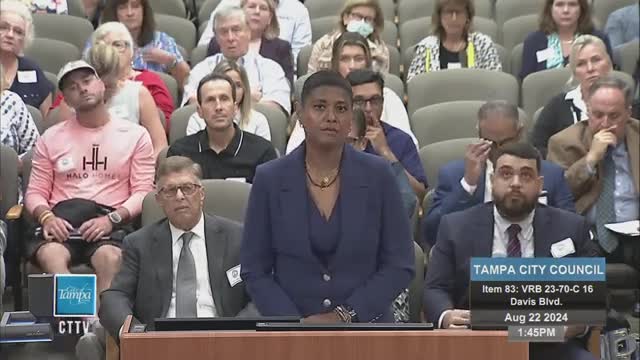City Council Approves Controversial Variance for Historic Building
August 23, 2024 | Tampa, Hillsborough County, Florida
This article was created by AI summarizing key points discussed. AI makes mistakes, so for full details and context, please refer to the video of the full meeting. Please report any errors so we can fix them. Report an error »

In a recent city council meeting, significant discussions centered around a variance request for a historic building located at 16 Davis Boulevard, known as Villa de Leon. The property owner, CLP 16, Davis, LLC, sought to reduce multiple yard setbacks from their current requirements to facilitate the elevation of the building and the construction of a parking garage beneath it.
The requests included reducing the east and west front yard setbacks from 45 feet to 1 foot, and the southwest and south side yard setbacks from 27 feet to 1 foot. The property is situated in the RM 24 zoning district, where typical setbacks are 25 feet for front yards and 7 feet for side yards. The variance was approved unanimously by the Variance Review Board (VRB) on May 14, 2024, with conditions that the variance would only apply to the existing structure and would terminate if the building were significantly damaged or destroyed.
During the meeting, concerns were raised by residents and representatives opposing the variance. They argued that the proposed changes would not only alter the character of the neighborhood but also exacerbate existing stormwater runoff issues, as the current courtyard would be replaced with a concrete parking structure. Critics emphasized that the applicant had not demonstrated a legitimate hardship, claiming that the need for the variance was self-imposed by the desire to build a garage.
Supporters of the variance, including the property owner’s attorney, highlighted the building's historical significance and the necessity of elevating it to comply with FEMA regulations, despite no legal obligation to do so. They argued that lifting the building would protect it from flooding and preserve its integrity for future generations.
The council was presented with various documents outlining the procedural history of the case, including the VRB's criteria for evaluating variance applications. The discussions underscored the tension between preserving historic structures and addressing modern zoning and environmental challenges. As the council deliberates, the implications of this decision could set a precedent for future developments in the area, particularly regarding how historic properties are managed in the face of contemporary urban planning needs.
The requests included reducing the east and west front yard setbacks from 45 feet to 1 foot, and the southwest and south side yard setbacks from 27 feet to 1 foot. The property is situated in the RM 24 zoning district, where typical setbacks are 25 feet for front yards and 7 feet for side yards. The variance was approved unanimously by the Variance Review Board (VRB) on May 14, 2024, with conditions that the variance would only apply to the existing structure and would terminate if the building were significantly damaged or destroyed.
During the meeting, concerns were raised by residents and representatives opposing the variance. They argued that the proposed changes would not only alter the character of the neighborhood but also exacerbate existing stormwater runoff issues, as the current courtyard would be replaced with a concrete parking structure. Critics emphasized that the applicant had not demonstrated a legitimate hardship, claiming that the need for the variance was self-imposed by the desire to build a garage.
Supporters of the variance, including the property owner’s attorney, highlighted the building's historical significance and the necessity of elevating it to comply with FEMA regulations, despite no legal obligation to do so. They argued that lifting the building would protect it from flooding and preserve its integrity for future generations.
The council was presented with various documents outlining the procedural history of the case, including the VRB's criteria for evaluating variance applications. The discussions underscored the tension between preserving historic structures and addressing modern zoning and environmental challenges. As the council deliberates, the implications of this decision could set a precedent for future developments in the area, particularly regarding how historic properties are managed in the face of contemporary urban planning needs.
View full meeting
This article is based on a recent meeting—watch the full video and explore the complete transcript for deeper insights into the discussion.
View full meeting